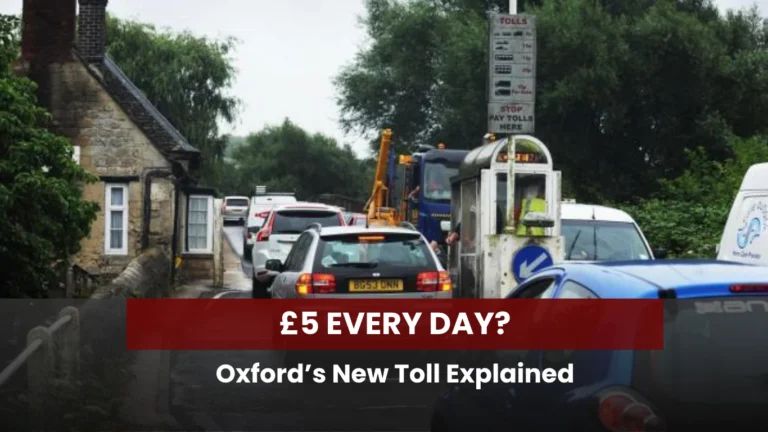If you drive through Oxford regularly, you’ve probably heard the buzz: a £5 daily toll is coming, and it could change the way residents, commuters, and visitors use the city’s roads. For years, Oxford has struggled with congestion and pollution. Now, local authorities are introducing a new toll scheme designed to cut traffic and improve air quality.
But what does this mean for drivers? Who will pay the Oxford £5 toll, where will it apply, and are there any exemptions? That’s what I’ll be covering in this guide. Get the Oxford toll scheme explained in simple, practical terms so you know what to expect.
Why Oxford Is Introducing a Toll
Oxford has long been known for its historic city center, narrow streets, and high volume of both cars and buses. Traffic congestion is a daily headache, with pollution levels often exceeding recommended limits.
The Oxford toll charge of £5 per day will be levied under the Oxford Zero Emission Zone (ZEZ) scheme. It is being introduced to discourage unnecessary car journeys, reduce emissions, and make the city more pedestrian- and cyclist-friendly. It’s part of Oxfordshire County Council’s wider efforts to reach net-zero emission targets and support clean air initiatives.
Other UK cities, like London, Birmingham, and Bath, already have similar congestion or clean air zones. But Oxford’s approach is unique: instead of a complicated vehicle emissions-based system, it’s a flat daily fee for entering or driving within designated parts of the city.
How Much Is the Oxford Toll?
This is the simplest part: the Oxford toll is £5 per day. You’ll pay once per day, no matter how many times you drive in and out of the zone. The charge applies 7 days a week, including weekends and bank holidays. Payments will likely be managed online, similar to London’s Congestion Charge system.
So if you’re a commuter driving into the city five days a week, you’re looking at about £25 per week, or roughly £100 per month. For occasional visitors, the cost will depend on how often you enter the Oxford toll zone.
Where Does the Oxford Toll Apply?
The exact boundaries of the Oxford toll zone are crucial for drivers. The zone will cover the busiest parts of Oxford city center, including roads leading directly into the historic core. Major arterial routes are expected to be included, meaning drivers just passing through Oxford, rather than stopping, will also be affected. Signage will clearly mark entry and exit points, and automatic number plate recognition (ANPR) cameras will enforce the scheme. If you live outside Oxford but often cut through the city on your commute, you’ll need to factor in this new toll in Oxford. The plan is to have the new Oxford daily toll in place by the 10th of November 2025. Details can be accessed from the official county website.
Oxford Toll Scheme Explained: How It Works
Here’s a step-by-step look at how the Oxford toll charge will operate:
- Entering the Zone: If your vehicle crosses into the defined Oxford toll area, ANPR cameras record your registration number.
- Daily Charge: A £5 fee applies to your vehicle for that day. Whether you drive in once or five times, it’s a single daily fee.
- Payment: You’ll need to pay online, by phone, or set up an automatic payment account.
- Penalties: Failure to pay by the deadline (usually midnight the following day, based on similar schemes) could lead to fines significantly higher than the toll itself.
When Does the Oxford Toll Start?
If you want to know when the Oxford toll starts, it is slated to begin by the 10th of November 2025. But wait for confirmation from the Oxfordshire County Council for the exact launch date. Initial pilot phases may run before full enforcement begins, allowing the city to fine-tune operations.
Oxford Toll Exemptions: Who Doesn’t Have to Pay?
Not everyone will need to pay the Oxford £5 per day charge. Exemptions and discounts are a big part of the debate.
Here are the likely Oxford toll exemptions:
- Residents of the zone: People who live within the toll area may receive discounts or full exemptions.
- Blue Badge holders: Disabled drivers are usually exempt from such charges.
- Emergency vehicles: Ambulances, fire engines, and police cars will not be charged.
- Public transport and essential services: Buses, waste collection, and possibly delivery vehicles may be exempt or discounted.
- Low-income commuters: The council is considering reduced rates or exemptions for workers earning below a certain threshold.
The full list of exemptions will be published closer to launch. But if you’re worried about how the scheme applies to you, keep an eye on council announcements.
The Impact of Oxford Toll on Drivers
So, how will the Oxford toll affect drivers?
For Residents:
Daily costs could add up, especially for those who rely on their cars for commuting, shopping, or school runs. However, improved bus and cycling infrastructure may offset the need to drive.
For Commuters:
Drivers from outside Oxford will face higher commuting costs. Many may consider switching to park-and-ride services, carpooling, or cycling to avoid the toll.
For Businesses:
Delivery companies, tradespeople, and small businesses may see operating costs rise. That said, reduced congestion could mean faster travel times inside the city.
For Visitors:
Tourists may see the £5 as a small price to pay for the convenience of driving in, but those on tight budgets might be encouraged to use public transport instead.
Environmental and Economic Benefits
Supporters argue the Oxford toll scheme is about more than revenue. It’s designed to provide:
- Cleaner air: Fewer cars mean lower emissions in a city with a history of air quality problems.
- Less congestion: Reduced traffic makes bus journeys faster and more reliable.
- Better cycling and walking: Safer, less polluted streets encourage healthier travel choices.
- Revenue for transport improvements: Funds raised from the toll could be reinvested into Oxford’s public transport, park-and-ride facilities, and cycling infrastructure.
In the long term, these changes could make Oxford a model for sustainable urban transport in the UK.
Criticisms of the Oxford £5 Toll
Not everyone is thrilled about the new Oxford £5 toll, particularly the residents of Oxford. Common criticisms include:
- Financial burden: Daily charges may hit low-income residents hardest.
- Limited alternatives: Some areas still lack convenient public transport, making car use unavoidable.
- Impact on business: Local shops and restaurants worry that fewer drivers could mean fewer customers.
- Inadequate consultation: Critics argue that the county council disregarded the apprehensions of residents and other stakeholders when deciding to levy the fee.
The council faces the challenge of balancing these concerns with the scheme’s environmental goals.
Alternatives to Paying the Toll
If you’re dreading the idea of paying a £5 daily toll, here are some options:
- Park-and-Ride: Oxford has multiple sites on the outskirts where you can park cheaply and take a bus into the city.
- Carpooling: Sharing rides splits costs and reduces traffic.
- Public Transport: Expanded bus routes are expected to accompany the toll rollout.
- Cycling and Walking: For those living nearby, it’s a healthier, toll-free option.
These alternatives are part of the council’s push to reduce reliance on private cars in the city centre.
FAQs About the Oxford £5 Toll
The toll is a flat £5 per day per vehicle, regardless of how many times you enter or leave the zone.
It applies within the designated Oxford toll zone, covering much of the city center and key entry points. Exact boundaries will be clearly signposted.
The scheme is scheduled to begin on the 10th of November 2025.
Residents within the zone, Blue Badge holders, emergency vehicles, and some essential services will likely be exempt or receive discounts.
Automatic number plate recognition (ANPR) cameras will record vehicles, and drivers must pay online or by phone. Failure to pay will result in fines.
Drivers face higher costs, but benefits include reduced congestion, cleaner air, and improved public transport.
Not exactly. London’s charge varies based on emissions, while Oxford’s is a flat daily fee for all vehicles.
Yes, by using park-and-ride, cycling, carpooling, or public transport instead of driving into the toll zone.
Conclusion
The Oxford £5 toll is set to reshape how people drive, commute, and visit the city. While the Oxford daily toll brings extra costs for many, its goals of reducing congestion, cutting pollution, and funding better transport could transform Oxford into a cleaner, more efficient place to live and work. For now, drivers should prepare for the change, watch for updates, and consider alternatives to paying the Oxford toll charge.
Get your daily dose of car news, new model reveals, EV updates, and smart buying advice only at Ask About Cars.



